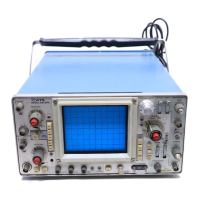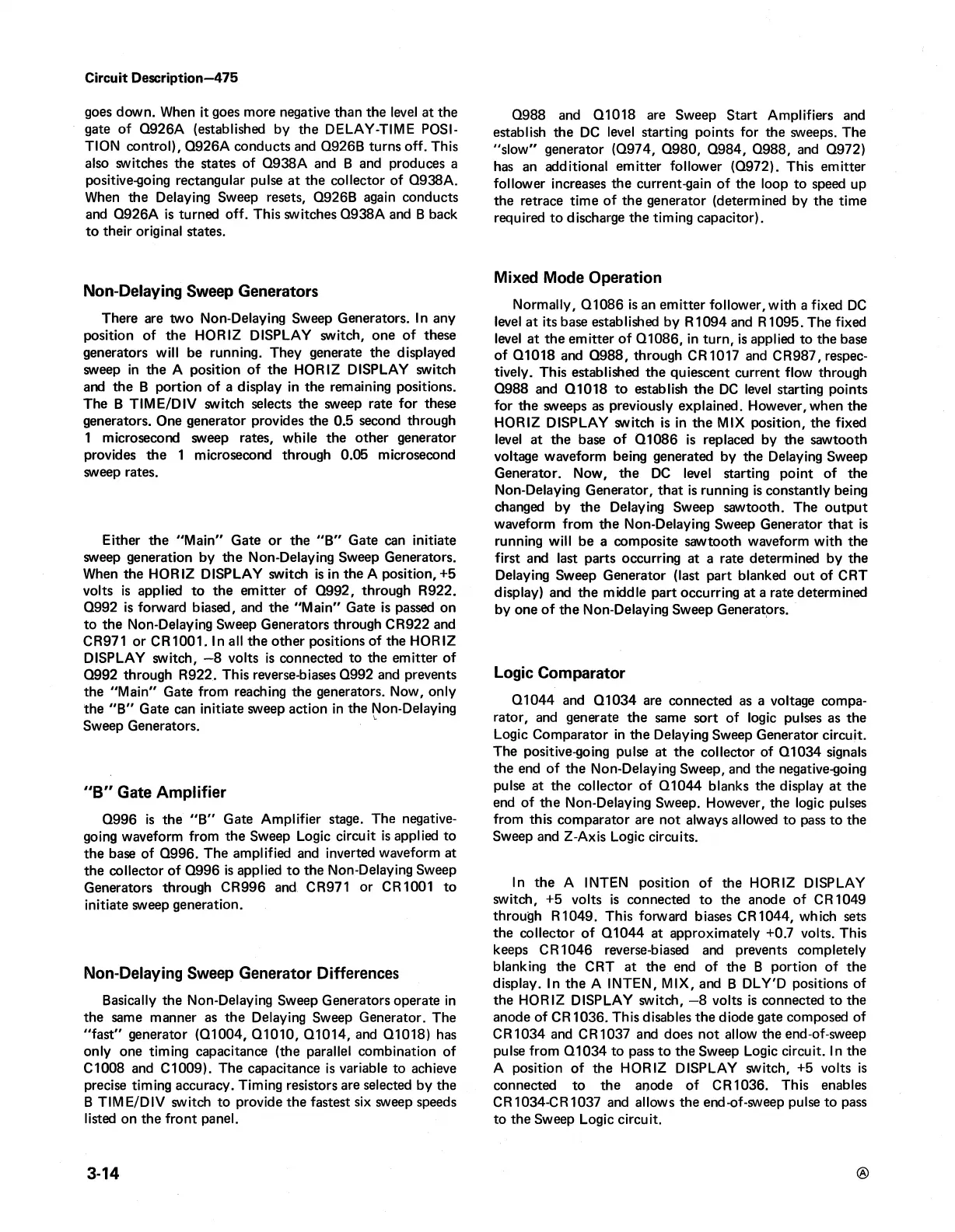Circuit Description—475
goes down. When it goes more negative than the level at the
gate of Q926A (established by the DELAY-TIME POSI
TION control), Q926A conducts and Q926B turns off. This
also switches the states of Q938A and B and produces a
positive-going rectangular pulse at the collector of Q938A.
When the Delaying Sweep resets, Q926B again conducts
and Q926A is turned off. This switches Q938A and B back
to their original states.
Non-Delaying Sweep Generators
There are two Non-Delaying Sweep Generators. In any
position of the HORIZ DISPLAY switch, one of these
generators will be running. They generate the displayed
sweep in the A position of the HORIZ DISPLAY switch
and the B portion of a display in the remaining positions.
The B TIM E /D IV switch selects the sweep rate for these
generators. One generator provides the 0.5 second through
1 microsecond sweep rates, while the other generator
provides the 1 microsecond through 0.05 microsecond
sweep rates.
Either the "Main" Gate or the "B" Gate can initiate
sweep generation by the Non-Delaying Sweep Generators.
When the HORIZ DISPLAY switch is in the A position, +5
volts is applied to the emitter of Q992, through R922.
Q992 is forward biased, and the "Main" Gate is passed on
to the Non-Delaying Sweep Generators through CR922 and
CR971 or CR1001. In all the other positions of the HORIZ
DISPLAY switch, —8 volts is connected to the emitter of
Q992 through R922. This reverse-biases Q992 and prevents
the "Main" Gate from reaching the generators. Now, only
the "B" Gate can initiate sweep action in the Non-Delaying
Sweep Generators.
"B" Gate Amplifier
Q996 is the "B" Gate Amplifier stage. The negative
going waveform from the Sweep Logic circuit is applied to
the base of Q996. The amplified and inverted waveform at
the collector of Q996 is applied to the Non-Delaying Sweep
Generators through CR996 and CR971 or CR1001 to
initiate sweep generation.
Non-Delaying Sweep Generator Differences
Basically the Non-Delaying Sweep Generators operate in
the same manner as the Delaying Sweep Generator. The
"fast" generator (Q1004, Q1010, Q1014, and Q1018) has
only one timing capacitance (the parallel combination of
C l008 and C l009). The capacitance is variable to achieve
precise timing accuracy. Timing resistors are selected by the
B T IM E /D IV switch to provide the fastest six sweep speeds
listed on the front panel.
Q988 and Q1018 are Sweep Start Amplifiers and
establish the DC level starting points for the sweeps. The
"slow" generator (Q974, Q980, Q984, Q988, and Q972)
has an additional emitter follower (Q972). This emitter
follower increases the current-gain of the loop to speed up
the retrace time of the generator (determined by the time
required to discharge the timing capacitor).
Mixed Mode Operation
Normally, Q1086 is an emitter follower, with a fixed DC
level at its base established by R1094 and R1095. The fixed
level at the emitter of Q1086, in turn, is applied to the base
of Q1018 and Q988, through CR1017 and CR987, respec
tively. This established the quiescent current flow through
Q988 and Q1018 to establish the DC level starting points
for the sweeps as previously explained. However, when the
HORIZ DISPLAY switch is in the M IX position, the fixed
level at the base of Q1086 is replaced by the sawtooth
voltage waveform being generated by the Delaying Sweep
Generator. Now, the DC level starting point of the
Non-Delaying Generator, that is running is constantly being
changed by the Delaying Sweep sawtooth. The output
waveform from the Non-Delaying Sweep Generator that is
running will be a composite sawtooth waveform with the
first and last parts occurring at a rate determined by the
Delaying Sweep Generator (last part blanked out of CRT
display) and the middle part occurring at a rate determined
by one of the Non-Delaying Sweep Generators.
Logic Comparator
Q1044 and Q1034 are connected as a voltage compa
rator, and generate the same sort of logic pulses as the
Logic Comparator in the Delaying Sweep Generator circuit.
The positive-going pulse at the collector of Q1034 signals
the end of the Non-Delaying Sweep, and the negative-going
pulse at the collector of Q1044 blanks the display at the
end of the Non-Delaying Sweep. However, the logic pulses
from this comparator are not always allowed to pass to the
Sweep and Z-Axis Logic circuits.
In the A INTEN position of the HORIZ DISPLAY
switch, +5 volts is connected to the anode of CR1049
through R1049. This forward biases CR1044, which sets
the collector of Q1044 at approximately +0.7 volts. This
keeps CR1046 reverse-biased and prevents completely
blanking the CRT at the end of the B portion of the
display. In the A INTEN, M IX , and B DLY'D positions of
the HORIZ DISPLAY switch, —8 volts is connected to the
anode of CR1036. This disables the diode gate composed of
CR1034 and CR1037 and does not allow the end-of-sweep
pulse from Q1034 to pass to the Sweep Logic circuit. In the
A position of the HORIZ DISPLAY switch, +5 volts is
connected to the anode of CR1036. This enables
CR1034-CR1037 and allows the end-of-sweep pulse to pass
to the Sweep Logic circuit.

